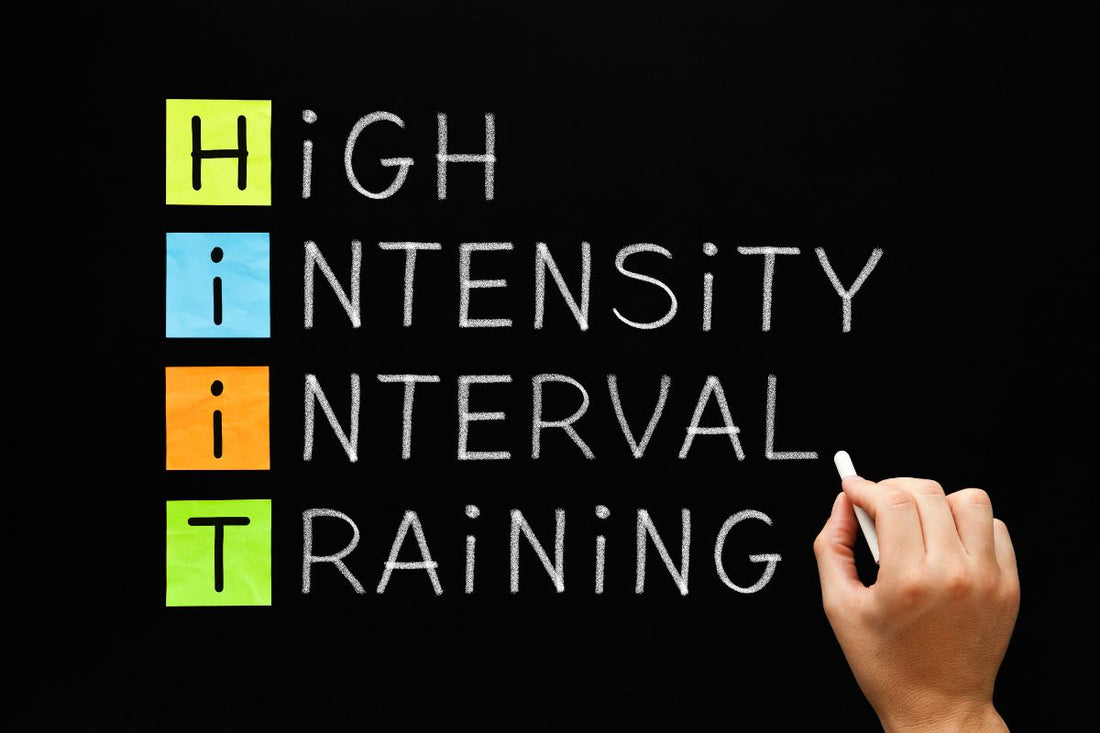Are you tired of spending hours at the gym without seeing the desired results? If so, it's time to give HIIT training a try. HIIT, or high-intensity interval training, is a workout method that has gained massive popularity in recent years – and for good reason. In just a short, intense session, you can maximize your fitness goals and achieve incredible results.
HIIT training involves performing short bursts of intense exercise, followed by brief periods of rest or active recovery. This workout technique not only burns calories during the session but also continues to burn calories long after you've finished. Plus, it helps improve cardiovascular health, boosts metabolism, and increases your overall stamina.
Whether you're a fitness enthusiast or a beginner looking to make the most of your workouts, HIIT training can be a game-changer. With its efficiency and effectiveness, you can say goodbye to endless hours on the treadmill and hello to quick and impactful sessions. So, get ready to push your limits and transform your fitness journey with the power of HIIT training.
What is HIIT training?
HIIT training is a form of exercise that involves alternating between short bursts of high-intensity exercise and periods of rest or active recovery. Unlike traditional steady-state cardio exercises, such as jogging or cycling at a moderate pace for an extended period, HIIT training pushes you to your limits in short bursts, making it a highly efficient and effective way to work out.
The idea behind HIIT training is to elevate your heart rate to a high level during the intense exercise periods, followed by a brief rest or recovery period that allows your heart rate to come back down. This cycle is repeated multiple times during a HIIT workout, providing a challenging and effective cardiovascular workout.
How does HIIT training work?
During a HIIT workout, your heart rate increases rapidly, pushing your body to work at its maximum capacity. This intense effort triggers various physiological responses in your body, such as increased oxygen consumption, improved muscle endurance, and enhanced fat burning.
The short bursts of high-intensity exercise force your body to tap into its energy reserves, depleting glycogen stores and increasing the demand for oxygen. This leads to an increased metabolic rate, which means you continue to burn calories even after your workout is over. This phenomenon is known as the "afterburn effect" or excess post-exercise oxygen consumption (EPOC).

Benefits of HIIT training
1. Efficient use of time: One of the biggest advantages of HIIT training is its time efficiency. With HIIT, you can achieve more in a shorter amount of time compared to traditional workouts. A typical HIIT session can last anywhere from 10 to 30 minutes, making it perfect for those with busy schedules.
2. Increased fat burning: HIIT training has been shown to be highly effective in burning fat. The intense effort during HIIT workouts causes your body to tap into its fat stores for energy. Additionally, the afterburn effect ensures that you continue to burn calories even after you've finished working out.
3. Improved cardiovascular health: HIIT workouts are excellent for improving cardiovascular health. The intense bursts of exercise during HIIT sessions help strengthen your heart and improve its efficiency, leading to better overall cardiovascular function.
4. Increased metabolism: HIIT training can significantly boost your metabolism. The high-intensity exercise stimulates the production of growth hormone, which helps increase muscle mass and improve your body's ability to burn calories.
5. Enhanced endurance and stamina: Regular HIIT training can improve your endurance and stamina levels. The intense nature of HIIT workouts pushes your body to adapt and become more efficient at utilizing oxygen, leading to improved performance in various physical activities.
The science behind HIIT training
The science behind HIIT training lies in its ability to target both the aerobic and anaerobic energy systems in the body. Aerobic exercise refers to activities that require oxygen, such as steady-state cardio, while anaerobic exercise relies on energy sources that do not require oxygen.
During the intense exercise periods of HIIT workouts, your body primarily relies on the anaerobic energy system, which uses stored energy sources like ATP and glycogen. As a result, your muscles are forced to work harder and adapt to the high-intensity demands.
The brief rest or recovery periods in HIIT workouts allow your body to partially replenish its oxygen stores and remove accumulated waste products, such as lactic acid. This enables you to continue performing at a high intensity during the next exercise interval.

HIIT training vs. traditional cardio workouts
When it comes to comparing HIIT training with traditional cardio workouts, there are a few key differences worth noting:
1. Time efficiency: HIIT training is much more time-efficient compared to traditional cardio workouts. A 20-minute HIIT session can provide similar or even better results compared to a 60-minute steady-state cardio session.
2. Calorie burn: HIIT training burns more calories in a shorter amount of time compared to traditional cardio workouts. The high-intensity nature of HIIT workouts keeps your heart rate elevated and triggers the afterburn effect, leading to increased calorie burn even after the workout.
3. Muscle preservation: Traditional cardio workouts, especially long-duration steady-state cardio, can lead to muscle loss. HIIT training, on the other hand, helps preserve muscle mass while burning fat, making it a better option for those looking to improve their body composition.
4. Metabolic benefits: HIIT training has been shown to boost metabolism for up to 48 hours after the workout, while traditional cardio workouts have a more limited impact on metabolic rate.
Designing a HIIT training workout
Designing an effective HIIT workout requires careful consideration of various factors, including exercise selection, intensity, duration, and rest periods. Here are some key guidelines to keep in mind when designing your HIIT training workout:
1. Choose your exercises: Start by selecting exercises that target multiple muscle groups and can be performed with proper form and technique. Examples include burpees, squat jumps, mountain climbers, and high knees.
2. Determine your work and rest intervals: The work intervals should be challenging enough to elevate your heart rate and push you to your limits. Aim for 20-60 seconds of intense exercise followed by 10-30 seconds of rest or active recovery. Remember to adjust the intervals based on your fitness level and goals.
3. Decide on the number of rounds: Depending on your fitness level and available time, choose the number of rounds you want to perform. Beginners may start with 3-4 rounds, while more advanced individuals can aim for 5-8 rounds.
4. Warm-up and cool-down: Always begin your HIIT workouts with a proper warm-up to prepare your body for the intense exercise. Include dynamic stretches and mobility exercises to increase blood flow and loosen up your muscles. After the workout, cool down with static stretches to improve flexibility and prevent muscle tightness.

HIIT training equipment and accessories
One of the great things about HIIT training is that it can be done with minimal equipment or even no equipment at all. However, there are some useful tools and accessories that can enhance your HIIT workouts and add variety to your routine:
1. Interval timer: An interval timer is essential for keeping track of your work and rest intervals during HIIT workouts. You can use a dedicated interval timer app on your smartphone or invest in a digital interval timer.
2. Resistance bands: Resistance bands are portable, lightweight, and versatile. They can add an extra challenge to your HIIT workouts by providing resistance and targeting specific muscle groups.
3. Dumbbells or kettlebells: Incorporating weighted exercises into your HIIT routine can increase the intensity and help build strength. Dumbbells or kettlebells are excellent choices for adding resistance to exercises like squats, lunges, and overhead presses.
4. Jump rope: Jumping rope is a simple yet effective way to incorporate cardio into your HIIT workouts. It improves coordination, agility, and cardiovascular endurance.
Common mistakes to avoid in HIIT training
While HIIT training can be highly effective, there are some common mistakes that people often make. Being aware of these mistakes can help you avoid potential pitfalls and get the most out of your HIIT workouts:
1. Neglecting proper form: It's crucial to maintain proper form and technique during HIIT exercises to prevent injuries and maximize results. Focus on performing each exercise with precision and control, even when fatigue sets in.
2. Overtraining: HIIT training is intense, and it's important to allow your body enough time to recover between sessions. Overtraining can lead to decreased performance, increased risk of injury, and burnout. Aim for 2-3 HIIT workouts per week with rest days in between.
3. Not listening to your body: Pay attention to how your body feels during HIIT workouts. If something doesn't feel right or you experience pain, modify or stop the exercise. Pushing through pain can lead to injuries and setbacks.
4. Neglecting warm-up and cool-down: Skipping the warm-up and cool-down can increase the risk of injury and delay recovery. Always take the time to properly warm up your muscles and gradually cool down to prevent muscle soreness.
5. Proper nutrition: If your diet is not dialed in, it won't matter how hard you train. As a general rule of thumb, cut out all processed food and beverages including alcohol, prioritize organic fruits, veggies, grass-fed meat and dairy, limit carbs and focus on high quality fats and protein, and start incorporating intermittent fasting like the 16/8 method.

HIIT training for different fitness levels
HIIT training can be adapted to suit individuals of different fitness levels, from beginners to advanced athletes. Here are some guidelines for each fitness level:
1. Beginners: If you're new to HIIT training or have a low fitness level, start with shorter work intervals (around 20-30 seconds) and longer rest periods (around 30-60 seconds). Focus on mastering the exercises and gradually increase the intensity and duration as you become more comfortable.
2. Intermediate: As you progress, you can increase the work intervals to 30-45 seconds and decrease the rest periods to 15-30 seconds. Challenge yourself by increasing the number of rounds or incorporating more challenging exercises.
3. Advanced: Advanced individuals can perform work intervals of 45-60 seconds with rest periods of 10-15 seconds. You can also experiment with more complex exercises or add weights to increase the intensity.
Here are a few free workouts to try!
Remember, it's essential to listen to your body and adjust the intensity and duration based on your individual fitness level and goals.
Conclusion
HIIT training is a powerful workout method that offers a multitude of benefits, including time efficiency, increased fat burning, improved cardiovascular health, and enhanced endurance. By incorporating short bursts of intense exercise into your routine, you can maximize your fitness goals and achieve incredible results.
Whether you're a fitness enthusiast or a beginner looking to make the most of your workouts, HIIT training can be a game-changer. With its efficiency and effectiveness, you can say goodbye to endless hours on the treadmill and hello to quick and impactful sessions. So, get ready to push your limits and transform your fitness journey with the power of HIIT training.
Hunghee Ancestral Energy is packed with the most bioavailable nutrients for peak performance and adventure - nutrition as nature intended. Whether you are a professional athlete, outdoor adventurer, or just hangry, Hunghee’s on-the-go 1oz superfood energy packs make it easy and convenient to ensure sustained energy for any activity. Made with animal-based nutrients including organic grass-fed ghee, local raw honey, and ancient sea salt, Hunghee provides a smooth release of energy. So next time you hit the trail or prepare for a long day, try a Hunghee!
Disclaimer: This content is for informational purposes only and is not intended as medical advice. Please consult your healthcare provider for advice about a specific medical condition or before starting any new fitness or nutritional program.

